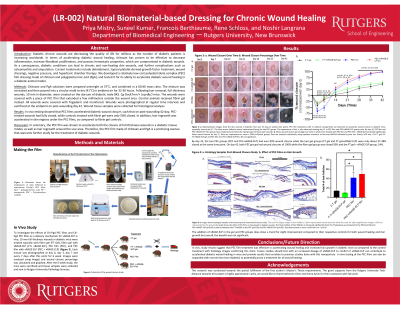Laboratory Research
(LR-002) Natural Biomaterial-based Dressing for Chronic Wound Healing
Friday, May 2, 2025
7:45 PM - 8:45 PM East Coast USA Time

Suneel Kumar, PhD; Noshir Langrana, PhD; Priya Mistry, MS; Rene Schloss, PhD
Introduction: Diabetic chronic wounds are decreasing the quality of life for millions as the number of diabetic patients is increasing worldwide. In terms of accelerating diabetic wound healing, chitosan has proven to be effective to decrease inflammation, increase fibroblast proliferation, and possess hemostatic properties, which are compromised in diabetic wounds. As a consequence, diabetic conditions can lead to chronic and non-healing skin wounds, and further complications such as osteomyelitis and amputation. Current treatments include debridement, topical platelet-derived growth factor treatment, wound dressings, negative pressure, and hyperbaric chamber therapy. We developed a relatively low-cost polyelectrolyte complex (PEC) film dressing made of chitosan and polygalacturonic acid (PgA), and tested it for its ability to accelerate diabetic wound healing in a diabetic animal model.
Methods: Chitosan and PgA solutions were prepared overnight at 37°C, and combined in a 60:40 mass ratio. The mixture was sonicated and then poured into a circular mold to dry (41°C) in ambient air for 32-36 hours. Following hair removal, full-thickness wounds, 10 mm in diameter, were created on the dorsum of diabetic male BKS. Cg-Dock7m+/+ Leprdb/J mice. The wounds were covered with a piece of PEC film that extended a few millimeters outside the wound area. Control animals received fibrin gel instead. All wounds were covered with Tegaderm and monitored. Wounds were photographed at regular time intervals and sacrificed at the endpoint on post-wounding day 42. Wound tissue samples were collected for histological analysis.
Results: In vivo testing showed that PEC films accelerated diabetic wound closure, such that on post-wounding 42-day, PEC-treated wounds had fully closed, while controls treated with fibrin gel were only 50% closed. In addition, hair regrowth was accelerated in skin regions under the PEC films, as compared to fibrin gel controls.
Discussion: In summary, the PEC film was shown to accelerate both the closure of full-thickness wounds in a diabetic mouse model, as well as hair regrowth around the scar area. Therefore, the PEC film made of,chitosan and PgA is a promising avenue that warrants further study for the treatment of diabetic wounds.
Methods: Chitosan and PgA solutions were prepared overnight at 37°C, and combined in a 60:40 mass ratio. The mixture was sonicated and then poured into a circular mold to dry (41°C) in ambient air for 32-36 hours. Following hair removal, full-thickness wounds, 10 mm in diameter, were created on the dorsum of diabetic male BKS. Cg-Dock7m+/+ Leprdb/J mice. The wounds were covered with a piece of PEC film that extended a few millimeters outside the wound area. Control animals received fibrin gel instead. All wounds were covered with Tegaderm and monitored. Wounds were photographed at regular time intervals and sacrificed at the endpoint on post-wounding day 42. Wound tissue samples were collected for histological analysis.
Results: In vivo testing showed that PEC films accelerated diabetic wound closure, such that on post-wounding 42-day, PEC-treated wounds had fully closed, while controls treated with fibrin gel were only 50% closed. In addition, hair regrowth was accelerated in skin regions under the PEC films, as compared to fibrin gel controls.
Discussion: In summary, the PEC film was shown to accelerate both the closure of full-thickness wounds in a diabetic mouse model, as well as hair regrowth around the scar area. Therefore, the PEC film made of,chitosan and PgA is a promising avenue that warrants further study for the treatment of diabetic wounds.

.jpg)